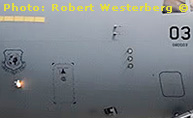|
|
Background
In the 1970s, the United States Air Force began looking for a replacement
for the Lockheed C-130 Hercules. USAF invited aircraft manufacturers
to a competition for the best design of an AMST (Advanced Medium STOL
Transport). STOL = Short Take Off and Landing.
Boeing presented their design YC-14 and McDonnell Douglas their
YC-15.
The competition was cancelled before any winner was chosen.
By 1980, the USAF found itself with a large fleet of aging C-141 Starlifter cargo aircraft. The type had to be replaced with a new, larger
aircraft. In 1981, McDonnell Douglas was chosen to build its proposed
aircraft, by then designated C-17. It differed from the YC-14 design in
having swept wings, increased size, and more powerful engines. This would
allow it to perform all work performed by the C-141, but to also fulfil
some of the duties of the C-5 Galaxy, freeing the C-5 fleet for outsize
cargo.
A first order of 210 aircraft was laid in 1985. Due to criticisms of the
project, the order was reduced to 120 aircraft in 1990. The first
prototype took to the air in September 1991.
The prototype (T-1) and five production models (P1-P5) were tested and
evaluated at Edwards Air Force Base. The C-17 received the “Globemaster
III” name in 1993.
The project met technical and production problems and the cost estimations
were overrun in an almost catastrophic way.
In 1997 McDonnell Douglas merged with its former competitor, Boeing. After
the fusion, the aircraft was marketed and manufactured as Boeing C-17 Globemaster III.
The C-17 carries the name of two previous U.S. military cargo aircraft,
the C-74 Globemaster and the C-124 Globemaster II.
In August 2010, a total of
220 C-17s were delivered. United States Air Forces (USAF)
operates 192 aircraft. C-17 is also operated by other countries:
Royal Australian Air Force (4 aircraft)
Canadian Forces Air Command (4 aircraft)
Qatari Air Force (2 aircraft)
Royal Air Force (6 aircraft)
SAC (3 aircraft, one of these on loan from USAF)
|
|
 |
Painting and Marking
The aircraft is painted in the standard
USAF light grey one colour scheme. I have got the information that the
Federal Standard code is 26173, but do not take this for granted.
The markings are in an USAF style. The tail is marked with the
Hungarian Air Force low visibility insignia. The name of the Hungarian
home base, PÁPA, is painted on the blue strip on the tail. Just
below are the two last digits of the serial number (01, 02 or 03) painted.
The
Hungarian low visibility insignia is also painted on the wings.
The last two digits of the
serial number are also painted in large size below the cockpit windows.
The complete serial number (080001, 080002 or 080003) is painted in
smaller digits just below. The badge seen aft of the entrance doors
is the insignia of the Heavy Airlift Wing (HAW).
See photos and drawing at
sides and below.
|
 |